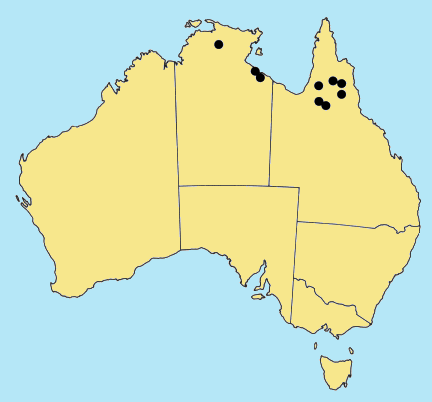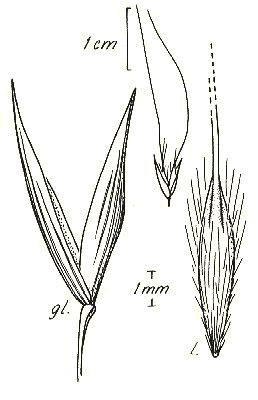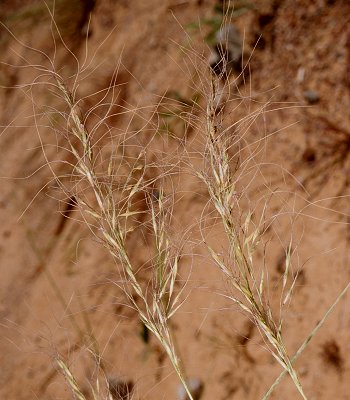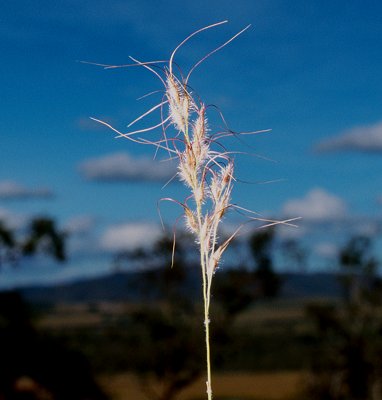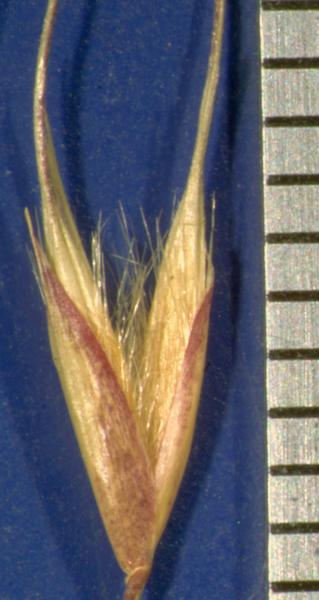Eriachne vesiculosa M. Lazarides. Aust.
Syst. Bot. 423 (1995).
Classification. (GPWG 2001) : Subfamily
Micrairoideae. Eriachneae.
Type of Basionym or
Protologue Information: Australia, Darwin & Gulf District: Craven
4246 (CANB holo).
Key references
(books and floras): [2002] D.Sharp & B.K.Simon, AusGrass, Grasses of
Australia.
Illustrations:
[2005] K.Mallet (ed.), Flora of Australia 44B: Poaceae 3 (Fig.
23C-E).
Habit.
Perennial. Stolons absent or present. Culms erect or geniculately ascending,
30–90 cm tall, 3–5 -noded. Mid-culm nodes pubescent or bearded. Lateral
branches branched or fastigiate. Leaf-sheaths glabrous on surface. Ligule a
fringe of hairs, 0.3–0.5 mm long. Leaf-blades convolute, 15–30 cm long, 2–3 mm
wide. Leaf-blade surface smooth or scabrous or papillose, glabrous or
indumented.
Inflorescence.
Inflorescence compound, a panicle. Panicle oblong, 5–10.5 cm long, 1–3.5 cm
wide.
Spikelets.
Spikelets pedicelled. Fertile spikelets 2-flowered, both fertile, comprising 2
fertile floret(s), without rachilla extension, ovate, laterally compressed, 6–9
mm long.
Glumes.
Glumes similar, thinner than fertile lemma. Lower glume lanceolate or elliptic,
cartilaginous, much thinner on margins, without keels, 7–9(–11) -nerved. Lower
glume surface glabrous. Upper glume lanceolate or elliptic, 6–9 mm long,
cartilaginous, without keels, 7–9(–11) -nerved. Upper glume surface smooth,
glabrous.
Florets.
Fertile lemma 4–8 mm long, without keel, 5 -nerved. Lemma surface indumented.
Lemma apex awned, 1 -awned. Median (principal) awn 18–30 mm long overall. Palea
2 -nerved. Palea apex dentate, awned (2). Anthers 3. Grain 2.5–3 mm long.
Continental
Distribution: Australasia.
Australian
Distribution: Northern Territory, Queensland.
Northern Territory:
Darwin & Gulf. Queensland: Burke, Cook.
Notes.
Distinguishing characters include fastigiately branched glabrous culms with
bearded nodes, tightly convolute vesicular blades, loose hairy panicle, firm
glabrous smooth muticous glumes, short (relative to glumes) often cleistogamous
florets with appressed lemma and palea, and obovate strongly compressed
caryopsis. The lemma is mostly indurated, bisulcate entirely hairy, and with a
curved scabrous grooved awn. The palea is indurated, beaked, biaristate
entirely hairy on the body, and with rounded keels. In spikelet morphology, E.
vesiculosa has similarities with E. stipacea and E. burkittii,
but differs from both by its vesicular leaf blades. Also, from E. stipacea
it differs by its grooved lemmas and muticous glumes, and from E. burkittii
by its entirely hirsute florets and biaristate paleas.
Endemic.
N of 19ºS in Qld and N.T. Growing usually in deep sandy often whitish soils, in
damp and seasonally flooded, often shaded sites, such as the channels and banks
of watercourses, stream lines and grassy swamps. Flowers and fruits Apr.-Aug.
(autumn and winter), and Oct. (mid-spring).
